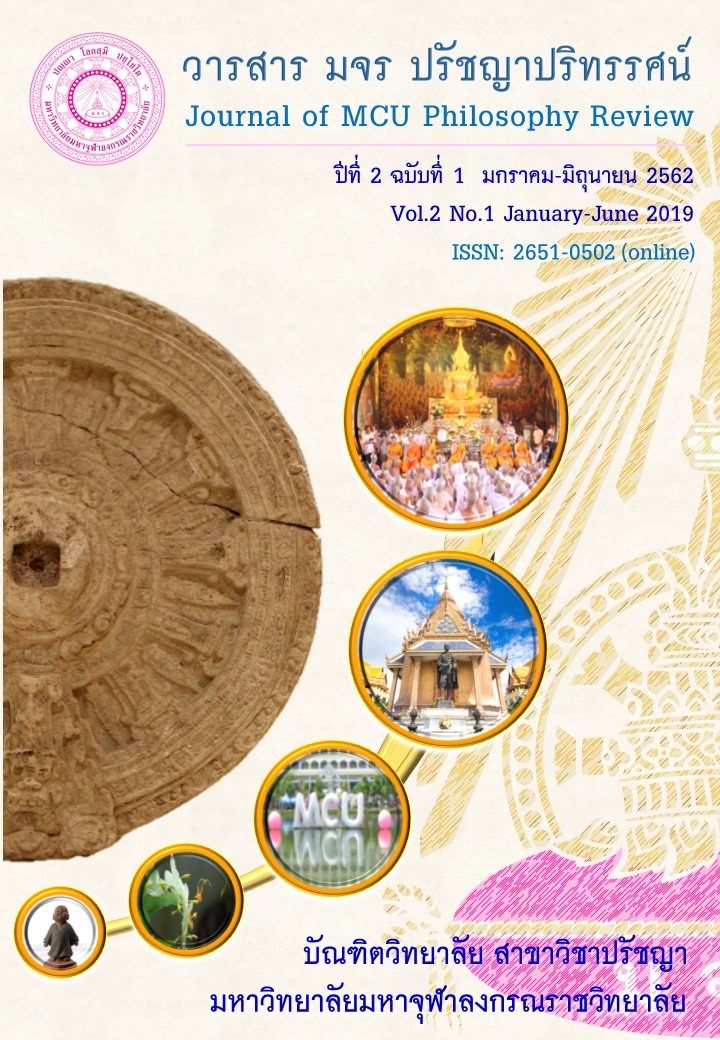The Eight Gurudhamma: The cause of the disappearance of Theravada Bhikkhuni
Main Article Content
Abstract
This article is the study of the famous book, It Happen in B.E. One, Vol.I and Vol.II by Venerable Mettanandho Bhikku, and viewpoints of the author. Especially the viewpoints of Gurudhamma and the disappearance of Theravada Bhikkuni, in which Buddhism is interpreted and explained through scientific frameworks. In the case of The Eight Gurudhamma is the cause of the disappearance of Theravada Bhikkhuni, the author ahows that The Eight Gurudhamma is not the words of the Buddha. It happens after the increase of bhikkhuni by the powerful bhikkhu at that time, which regard and treat bhikkhuni as a mere adjunct of man, with an aim to eliminate Theravada Bhikkhuni. This article studies the viewpoint of the author and the other educators in three points. 1. The Eight Gurudhamma and the word of the Buddha. 2. Feminism in Theravada Buddhism. 3. The cause of the disappearance of Theravada Bhikkhuni after the parinibbana of the Buddha. From the viewpoint of many educators show the reasons to argue the interpretations of the author, the fault in which Buddhism is interpreted and explained through scientific frameworks, such as, Einstein’s theory of relativity and Mahapadesa, the status and the roles played by the women during the Buddha’s life and feminism, also the historic reason to assist the disappearance of Theravada Bhikkhuni after the parinibbana of the Buddha. Significantly, the reason of many educators reduces the weight to rely on the interpretation of the author. Absolutely, the interpretation of the author not to be in line with the Tipitaka. Therefore, The Eight Gurudhamma is the words of the Buddha, and is not exactly the cause of the disappearance of Theravada Bhikkhuni.
Article Details
บทความที่ได้รับการตีพิมพ์เป็นลิขสิทธิ์ของวารสาร มจร ปรัชญาปริทรรศน์
ข้อความในบทความที่ได้รับการตีพิมพ์ในวารสาร ถือเป็นความรับผิดชอบของผู้เขียนบทความ และข้อคิดเห็นนั้นไม่ถือว่าเป็นทัศนะและความรับผิดชอบของกองบรรณาธิการวารสาร มจร ปรัชญาปริทรรศน์
References
พระธรรมปิฎก (ป.อ.ปยุตฺโต). (2543). กรณีเงื่อนงำ : พระพุทธเจ้าปรินิพพานด้วยโรคอะไร. กรุงเทพมหานคร : บริษัทสหธรรมิก.
พระพรหมคุณาภรณ์ (ป.อ. ปยุตโต). (2551). พจนานุกรมพุทธศาสน์ ฉบับประมวลศัพท์. พิมพ์ครั้งที่ 11. กรุงเทพมหานคร : บริษัท เอส อาร์ พริ้นติ้ง แนสโปรดักส์ จำกัด.
มหาจุฬาลงกรณ์ราชวิทยาลัย. (2539). พระไตรปิฎกภาษาไทย ฉบับมหาจุฬาลงกรณราชวิทยาลัย. กรุงเทพมหานคร : มหาจุฬาลงกรณราชวิทยาลัย.
เมตฺตานนฺโท ภิกฺขุ. (2555 ก). เหตุเกิด พ.ศ. 1 เล่ม 1. กรุงเทพมหานคร : สำนักพิมพ์พระอาทิตย์.
เมตฺตานนฺโท ภิกฺขุ. (2555 ข). เหตุเกิด พ.ศ. 1 เล่ม 2. กรุงเทพมหานคร : สำนักพิมพ์พระอาทิตย์.
ราชบัณฑิตยสถาน. (2550). พจนานุกรมศัพท์ปรัชญา อังกฤษ-ไทย. ฉบับแก้ไขเพิ่มเติม. พิมพ์ครั้งที่ 2. กรุงเทพมหานคร: ห้างหุ้นส่วนจำกัด อรุณการพิมพ์.
พระมหานิพนธ์ อหึสโก (ทองดีนอก). (2553). “การศึกษาวิเคราะห์สถานภาพและบทบาทของสตรีที่ปรากฏในคัมภีร์ธัมมปทัฏฐกถา”. วิทยานิพนธ์พุทธศาสตรมหาบัณฑิต. บัณฑิตวิทยาลัย : มหาวิทยาลัยมหาจุฬาลงกรณราชวิทยาลัย.
แม่ชี กฤษณา รักษาโฉม. (2551). “การศึกษาปัญหาเรื่องการเสื่อมสูญของภิกษุณีสงฆ์ในพระพุทธศาสนาเถรวาท”. วิทยานิพนธ์พุทธศาสตรดุษฎีบัณฑิต. บัณฑิตวิทยาลัย : มหาวิทยาลัยมหาจุฬาลงกรณราชวิทยาลัย.
ปกรณ์ สิงห์สุริยา. ผศ.ดร. (2555). “การตีความและอธิบายพระพุทธศาสนาด้วยกรอบความคิดทางวิทยาศาสตร์ : กรณีศึกษา”. รายงานวิจัยโครงการวิจัยศูนย์พุทธศาสน์ศึกษา : จุฬาลงกรณ์มหาวิทยาลัย.
มนตรี สืบด้วง. (2549). “ครุธรรมกับความเป็นพุทธพจน์”. สารนิพนธ์พุทธศาสตรดุษฎีบัณฑิต. บัณฑิตวิทยาลัย : มหาวิทยาลัยมหาจุฬาลงกรณราชวิทยาลัย.
วีรชาติ นิ่มอนงค์. ดร. (2552). “การศึกษาวิเคราะห์ทฤษฎีอรรถปริวรรตศาสตร์ในคัมภีร์พระพุทธศาสนาเถรวาท”. รายงานวิจัย. สถาบันวิจัยพุทธศาสตร์ : มหาวิทยาลัยมหาจุฬาลงกรณราชวิทยาลัย.


